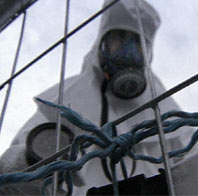|
"Dirty Bomb" probes the realities and implications for public health
policy of a disaster that many consider to be all but inevitable: a
terrorist attack on a major city using a radioactive "dirty bomb."
The program strives to answer crucial questions about this menacing
new weapon in the terrorists' arsenal, questions such as: What
exactly is a dirty bomb? How dangerous could one be, and how much
radiation could it release? What will need to be done to clean up
after an explosion?
Unlike a nuclear bomb, which can destroy an entire city, a dirty
bomb does most of its work psychologically. Diabolically simple, the
device is made of nothing more than conventional explosives wrapped
around some unrefined radioactive material, such as strontium,
cobalt, or cesium—all obtainable from thousands of poorly
regulated sources.
To test the consequences of a projected attack, "Dirty Bomb"
dramatizes two scenarios based on sophisticated models developed by
a team of radiation experts, including Michael Levi, the director of
the Strategic Security Project at the Federation of American
Scientists. One of these scenarios looks at the consequences of a
dirty-bomb detonation in the Washington, D.C., subway system, and
the other at a detonation's aftermath in Trafalgar Square, London.
More sobering than the direct effects of any explosion, however, is
that an incident like the ones dramatized in "Dirty Bomb" could
cause widespread panic and crippling damage to the
economy—achieving the terrorists' fondest wishes—even if
no one died when the bomb went off.
U.S. officials are convinced that some sort of dirty-bomb attack is
imminent. In spring 2002 American Al Qaeda sympathizer Jose Padilla
was arrested on suspicion of planning a dirty-bomb attack in the
U.S. Several months earlier, American intelligence agents in
Afghanistan uncovered detailed Al Qaeda plans for a sophisticated
version of a dirty bomb.
"The understanding was basically at a fairly advanced physics
level," says former CIA head of intelligence Vince Cannistraro. "It
wasn't just the kind of formula that you might be able to pick up
off the Web.... It was a pretty well-thought-out scenario on how to
make the most deadly kind of dirty bomb imaginable."
Aside from the effect of the explosion itself, which would injure or
kill those in its immediate vicinity, some people near the blast
might be exposed to levels of ionizing radiation high enough to
cause sickness or death. Many others would be at risk from
radioactive contamination that could linger for decades or even
centuries, causing an increased rate of cancer if nothing is done to
clean the area. Even if quite small, the increased cancer risk may
be unacceptable to the public, leading to demolition or abandonment
of affected areas at a cost of billions, and potentially trillions,
of dollars.
Experts have already learned what to expect from previous accidents.
In Goiaina, Brazil, in 1988, a radiation contamination incident
occurred in which a small quantity of radioactive cesium chloride
discovered by scrap-metal merchants led to four deaths and an
enormous cleanup effort. Decontamination took six months and
generated more than 5,000 cubic yards of radioactive waste. (For
more on this tragedy, see
Chronology of Events.)
More serious incidents have occurred in the former USSR, where many
tons of radioactive substances were produced for experimental crop
treatment and other uses during the Soviet era. Much of this
extremely dangerous material is now at large. The program shows an
incident in the Republic of Georgia, in which a security team
disposes of a deadly canister of strontium that was discovered by
hunters. Each member of the security team could spend only 40
seconds near the highly lethal source before reaching maximum
allowable exposure.
Even the U.S. has had close brushes with accidental nuclear
contamination, including a cesium industrial gauge that was
discovered in a scrap yard in North Carolina—fortunately,
before it was melted down. And in 1988, radioactive needles for
cancer treatment disappeared from a hospital in Greensboro, N.C.,
and have yet to be found.
"We certainly have problems in our own backyard," concedes Dr. Jack
Caravelli of the U.S. Department of Energy. "Do I worry about a
dirty bomb being made from material of American origin? Yes, I do."


|

|
As if the threat of conventional and biological
terrorism weren't enough to contend with, we also have
to prepare ourselves for radiological
terrorism—the use of so-called "dirty bombs."
|
|
|

